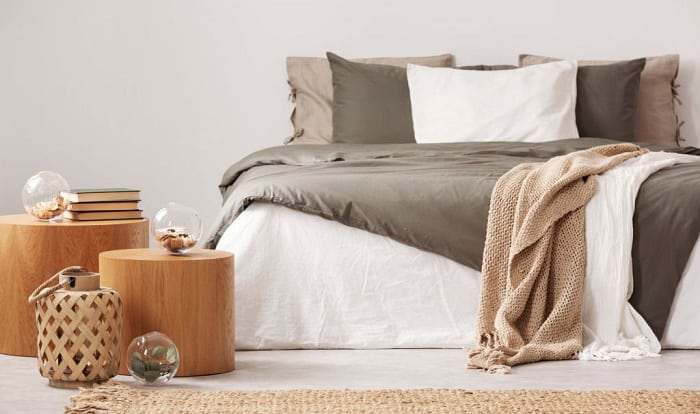Are you wondering which linen you should use for your bedroom? In the battle of blanket vs comforter, deciding the winner can be tricky when you don’t even know the difference between comforter and blanket.
To make the matter worse, you’ll often see these two words used interchangeably so many times that it’ll beg the question, is a comforter a blanket. Rest assured, the explanation below offers you everything you need to know in this article.
| Aspects | Comforters | Blankets |
| Number of Layers | – Multiple layers | – One layer only |
| Fillings | – Feathers from ducks/geese
– Cruelty-free alternatives such as wool, silk, synthetic filling, or cotton |
– None |
| Some Notable Types | – Down-filled, fur, silk, wool, polyester, Faux Suede, cotton, satin, brocade, flannel, etc. | – Fleece, wool, polyester, cotton, acrylic, microfiber, afghan, etc. |
| Insulating Capacity | – Depending on fillings
– Typically warmer than blankets |
– Depending on thickness and material.
– Not as warm as comforters |
| When To Use? | – Cold seasons | – Warmer seasons |
| Storage | – Hard to fold
– Take up more space |
– Easy to fold
– Can fit into cramped spaces |
| Maintenance | – Requires specific cleaning procedures
– Harder than blankets |
– Generally straightforward |
| Dust Mite Resistance | – More vulnerable to dust mites | – Still susceptible to dust mites, but less so than comforters |
| Price Range | – $50 to $400 | – $5 to $150 |
Table of Contents
Overview of Blankets and Comforters
1. Comforters
Comforters are thick bed linens that have an outer layer and a thick filling. Fillings for comforters can range from natural down to animal-friendly alternatives such as cotton, wool, silk, or synthetic filling. These fillings are usually kept in place by quilting.
Comforter sets can arrive in many types, depending on their materials. For example, bamboo comforters are made from bamboo viscose, which gives them impressive durability, a silky texture, and excellent breathability.
The filling materials also affect how comforters feel. Cotton, the most popular choice nowadays, is favored due to its lightness, breathability, and quick absorption rate. Meanwhile, duck or goose feathers are famous for their warmth and fluffy feeling.
Pros
- Features many layers and a thick filling to provide more warmth
- Usually very durable, it can last 15-25 years
- Provides more comfort with its soft and fluffy texture
- Suitable for winters and cold regions
- Versatile as comforters used for bed covers can also be used as a blanket or under blanket.
- Add style points to your home with its posh appearance
- Most comforters nowadays have excellent breathability
- Does not require regular washing
Cons
- Susceptible to dust mites, which can trigger an allergy in some people
- Take up more storage space due to their large size
- Can be quite pricey
- Require special efforts and a high cost to clean
2. Blankets
Blankets are a thick single-layered fabric used as coverings to keep you warm. They are rectangular, and they should be at least thicker than a bedsheet to have adequate insulation capacity.
Similar to comforters, blankets are available in many types. The most common ones are wool and fleece, as these two can provide the most warmth.
Based on how the blankets are made, you can also categorize them into crochet, knitted, or woven blankets.
Another popular choice that has appeared recently is electrical blankets, with internal wiring powered by electricity. This gives them fantastic insulation properties, making them an ideal choice if you want to use a blanket instead of comforter sets.
Pros
- More affordable
- Doesn’t take up too much storage space
- Relatively effortless to clean and maintain
- Less likely to trap dust mites and cause allergies
- Lightweight and amazing breathability
- You can get weighted blankets or electrical blankets for better heating
Cons
- Might require replacement soon
- Insulation properties might not be sufficient during colder seasons
Comforters Vs Blankets – A Full Showdown
From product material to maintenance requirements, there are several factors that set these two products apart. Check out the difference between blanket and comforter to know which one suits your needs the most.
1. Number Of Layers And Fillings
This is the most fundamental distinction between blanket vs comforter. Whereas blankets are single-layered, bed comforter meaning indicates they consist of at least three – two outer covers and one thick filling inside.
As blankets are only one layer, they contain no filling. On the other hand, comforters always have fillings.
Five main types of comforter filling include natural downs, cotton, wool, silk, and synthetic filling.
2. Insulation Properties And Compatible Seasons
Their thick fillings make comforters’ insulation capacity second to none. Their warmth can keep you cozy even in the bitterly cold winter. As most comforters have a fluffy texture, they’re perfect for snuggling up against when you are cold.
Meanwhile, blankets are suitable for warm seasons, where most will find comforters too hot to bear. Since blankets are generally more lightweight, they tend to have better permeability, making the covers less suffocating when the weather gets hot.
However, some comforters nowadays allow you to remove or add the filling as you please, which might make them more compatible with the warm weather. Sewn-through comforters, nonetheless, are impossible to customize to your liking.
3. Ease Of Storage
Comforters’ fluffiness can be wonderful to snuggle up against in the winter, but it can be a pain when you need to put them away.
Comforters are notoriously hard to fold as they loosen up quickly and will take up a chunk of storage space in your closet.
The best way to store comforters I’ve learned so far is to fold them into a pillow. I first came across this tip on Reddit, and it remains my favorite hack. Here is a recreation of that hack for you to try yourself.
How to fold a comforter
Fortunately, it’s a lot easier to fold a blanket. Blankets don’t take up much space either, which makes putting them away quite effortless.
4. Maintenance Requirements
The tricky thing about comforters is that they usually can’t be washed by conventional means. Though they require fewer washings (2-3 times per year) than blankets, you usually need to dry-clean them to prevent the filling from forming lumps.
To properly care for your comforters, you should always read the instruction label first. If you’re lucky, you can wash your comforter in a washing machine, as long as you select gentle cycles.
5. Dust Mite Resistance
Comforters’ thick fillings make them trap quite a lot of dust mites, which is one of the leading causes of allergic reactions. You can rectify this issue by washing them every once in a while or storing them in an airtight cover when not in use.
Blankets’ woven fabric and lack of fillings mean they’re less susceptible to dust mites. However, you’ll still need to wash the blankets regularly to prevent these pests.
6. Price Range
Most comforters are pricier than blankets. Whereas blankets on average cost $5-$150, you can expect to spend $50-400 for comforters.
It’s also not uncommon to spend more money on maintaining comforters than blankets.
FAQs
Can I use comforters as blankets?
Absolutely! Although comforters are designed to be bed covers, they still make a great blanket during the cold seasons. During these chilly times, it’ll feel incredible to sleep under a fluffy comforter with a blanket on top.
However, it’s not wrong to put a blanket between you and a comforter either. With the blanket in-between, your comforter will require less cleaning and maintenance. It’ll also stop the comforter from agitating your skin if the comforter’s material feels rough.
Is it okay to sleep on top of comforters?
There’s nothing wrong with sleeping on top of a comforter. In fact, doing so in the winter seasons can keep you warm better in your sleep. However, keep in mind that this will also dirty your comforter quicker.
How do I choose between a comforter and a blanket?
It all depends on your preferences and how your room’s temperature changes throughout the year. If you live somewhere warm all year round, comforters might be a bit overkill. Cold regions, however, absolutely need comforters’ insulation capacity.
Other than that, you should also think about how you want to set the tone of your bedroom. Besides the wall colors and furniture, accessories such as bedclothes can also affect the overall ambiance of your room.
Can I place a heated blanket under comforters?
No, you are not supposed to put a heated blanket under comforter. Perhaps you’re confusing a heated blanket with a heated mattress pad, which you can lie on. On the other hand, heated blankets should be put on top of a regular blanket.
Conclusion
Now that you’ve learned the difference between comforter and blanket, I’m certain it’s much easier to make up your mind.
Feel free to share the article with others who are also pondering between these two options for their new bedroom.
Read more other articles:
- The place to put a TV in a bedroom.
- Ways to get rid of weevils in my bedroom.
- Average bedroom dimensions.

Hi, I am Roseanne Jones, an aspiring home designer that wants to make you feel more at home with your new house.With nearly five years of redecorating old residents and arranging new ones, I am confident that I can give you the best advice on your lovely place.






















